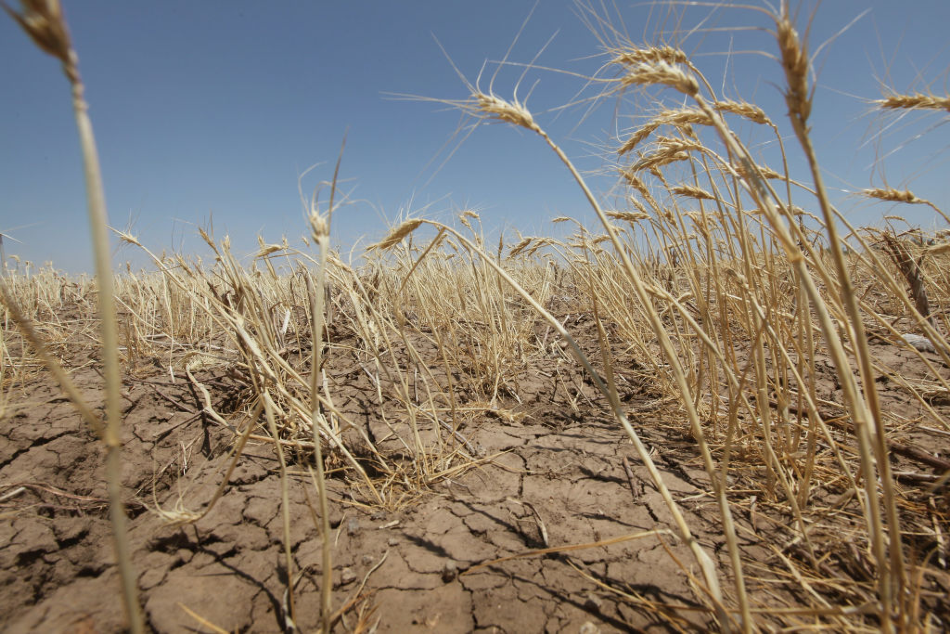Jul 9 2020
According to a research team headed by a professor from Texas A&M University, climate in Texas will feature drier summers and reduced water supplies for most parts of the state for the rest of the 21st century—probably leading to the driest conditions the state has encountered in the last 1,000 years.
 A drought-stricken wheat field bakes in the sun July 27th, 2011, near Hermleigh, Texas. A severe drought had caused the majority of dry-land crops to fail in the region. The past nine months had been the driest in Texas at the time since record keeping began in 1895. Image Credit: Scott Olson/Getty Images.
A drought-stricken wheat field bakes in the sun July 27th, 2011, near Hermleigh, Texas. A severe drought had caused the majority of dry-land crops to fail in the region. The past nine months had been the driest in Texas at the time since record keeping began in 1895. Image Credit: Scott Olson/Getty Images.
The researchers employed the most sophisticated climate models to estimate the drought conditions and applicable data for stakeholders such as large surface water suppliers, agricultural producers, regional water planning districts, and small groundwater water districts.
The team identified a clear message: Texas is becoming drier and hotter, and now is the time to take measures to mitigate this.
According to Regents Professor John Nielsen-Gammon, director of the Texas Center for Climate Studies and the Texas State Climatologist, the data indicates Texas was much wetter 10 to 15,000 years ago, when it came out of the last Ice Age.
From that time, the climate of Texas has been mostly similar to the present, except for a few drier and wetter periods. Over the past thousand years, there have been several decades of prolonged drought periods known as “megadroughts”—something Texas will possibly encounter through the end of the century.
Our study shows that the drier conditions expected in the latter half of the 21st century could be drier than any of those megadroughts, depending on how you measure dryness.
John Nielsen-Gammon, Regents Professor and Director, Texas Center for Climate Studies, Texas A&M University
Together with his collaborators from the University of Texas at Austin, Texas State University, the University of Oklahoma, NASA, and others, Nielsen-Gammon had recently published the study in the Earth’s Future journal.
According to the study, although the policymakers of Texas have designed conservation plans and water projections for decades, these have failed in several regions.
The 1950s drought remains the “drought of record” and the most severe one in Texas over the last 125 years. However, the present water plans have not taken into account the probable decrease in Texas’ water supply as a result of the future climate change.
The state water plan doesn’t explicitly consider climate change in figuring out how water supply and water demand will both change. As our paper points out, pinning numbers on either of those changes is a difficult challenge, and it’s not simply a matter of estimating changes in precipitation.
John Nielsen-Gammon, Professor and Director, Texas Center for Climate Studies, Texas A&M University
Nielsen-Gammon added, “Tying future water supply to criteria established by the drought of record is a defensible choice, but policymakers should be aware that the chances of exceeding the drought of record are probably increasing year by year.”
The study reports that parts of Texas will probably experience ever-drier conditions compared to the remaining regions of the state.
As per the report, particularly, West Texas is more prone to drought or even megadrought conditions.
West Texas seems most likely to get a double whammy: decreased rainfall and increased temperatures. Even though rainfall has increased statewide over the past century by about 10 percent, West Texas has seen little to no increase.
John Nielsen-Gammon, Professor and Director, Texas Center for Climate Studies, Texas A&M University
Nielsen-Gammon continued, “West Texas is already planning for what happens as one or more critical aquifers get depleted. Climate change is going to make that depletion happen a little bit faster, but the decline of the Ogallala Aquifer is primarily caused by water extraction for irrigation rather than by climate change.”
According to Nielsen-Gammon, Texas may turn hotter and drier since any long-term variations in precipitation will be “dwarfed” by how much more evaporation will lead to water supply depletion.
However, droughts are short-lived by definition, so we should not imagine the future as a condition of permanent drought, added Nielsen-Gammon.
Nielsen-Gammon said, “It’s really a change in the climate, with the normally dry conditions in West Texas slowly migrating toward East Texas.”
Nielsen-Gammon stated that the intensity of the future dryness will probably be based on local conditions. However, there are some important questions to be answered.
Nielsen-Gammon says, “These include ones such as, does it matter what time of year sees increases or decreases in precipitation? How much water supply is there? Is the most important issue the amount of water or the health of the crops and foliage? Is it more important to get runoff or to have the rainfall soak into the ground?”
The study was financially supported by the National Science Foundation, the Cynthia and George Mitchell Foundation, and the University of Texas at Austin’s Planet Texas 2050 Bridging Barriers research initiative.
Journal Reference:
Nielsen-Gammon, J. W., et al. (2020) Unprecedented drought challenges for Texas water resources in a changing climate: what do researchers and stakeholders need to know? Earth’s Future. doi.org/10.1029/2020EF001552.